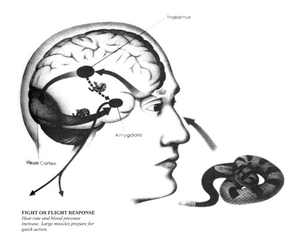AMYGDALA HIJACK

Instructions
Let's have a closer look at the reactive responses and what they are all about.
Our reactive responses stem from the way our brain is wired – let’s look at why we react to some things and not others
There are 3 parts of the brain:
Neo-cortex (thinking part of the brain)
Limbic (emotions part of the brain)
Reptilian (adapting to our environment)

If you look at the history of the development of the brain – in manual – there’s a part of our brain that’s called the Amygdala, Greek for almond shaped. This is in the Limbic part of the brain whose purpose is to ensure physical survival – fear based part of the brain, as an alarm bell for physical danger.
The amygdala is activated as an instant response to situations without going through the thinking part of the brain (neo-cortex) – jumping off street when car speeding towards you
All throughout our lives when we feel fear from an experience, the amygdala remembers. It is poised to trigger that same reaction if it looks like….it smells like…. it sounds like…anything from that previous experience – it associates it with fear, and throws us into what is called an “amygdala hi-jack.” It hi-jacks our brain – it makes us react rather than think about the situation.
So, it serves us for protecting our physical survival when we feel fear, but the point to all this is are any of the behaviours we captured on the chart physical survival situations? No
What is the amygdala protecting? The ego and this is what happens when our ego feels fear – it is protecting it. (point to board)
Our amygdala has all these reactive responses ready to activate as soon as we feel fear - in any situation - physical or ego. They come in three common forms (as mentioned:
Fight – ready to cause pain and hurt. (go to board and circle) Which or our behaviours are fight patterns?
Flight – get way because it is too painful. Which of our responses are flight patterns?
Freeze – too overwhelmed and which are those responses?
These have developed over our lives, right back before we could even talk (pre-verbal stage). In early interactions in life, we experience them as feeling reactions rather than logical or rational responses. Eg a baby cannot think it is hungry – it feels it, and then learns to cry to get fed. The amygdala learns to do what is needed.
In this pre-verbal stage we experience what fear feels like. Then whenever we have an experience that is potentially harmful, the amygdala remembers this original feeling of fear and reacts - or hijacks us – sometimes we don’t even know it.
What happens when a lot of people in a team are reactive? How is the environment? (Reiterate the below the line – fff/survival – leads to fear – blame, judgement and mistrust).
Attachments
- image.png
Background
The Amygdala is a gland in our brain ensuring our physical survival – it is a hardwired automatic response to a stimulus when we feel fear – in these situations it is vital for our survival
3 reactive responses FFF
The amygdala patterns are developed from an early age and we are still using the same road map as an adult!